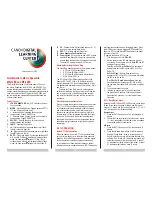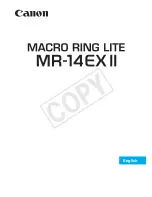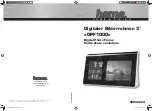
10
3.4.
General Description About Lead Free Solder (PbF)
The lead free solder has been used in the mounting process of all electrical components on the printed circuit boards used for this
equipment in considering the globally environmental conservation.
The normal solder is the alloy of tin (Sn) and lead (Pb). On the other hand, the lead free solder is the alloy mainly consists of tin
(Sn), silver (Ag) and Copper (Cu), and the melting point of the lead free solder is higher approx.30 °C (86 °F) more than that of the
normal solder.
Definition of PCB Lead Free Solder being used
Service caution for repair work using Lead Free Solder (PbF)
• The lead free solder has to be used when repairing the equipment for which the lead free solder is used.
• (Definition: The letter of
is printed on the P.C.B. using the lead free solder.)
• To put lead free solder, it should be well molten and mixed with the original lead free solder.
• Remove the remaining lead free solder on the P.C.B. cleanly for soldering of the new IC.
• Since the melting point of the lead free solder is higher than that of the normal lead solder, it takes the longer time to melt the
lead free solder.
• Use the soldering iron (more than 70W) equipped with the temperature control after setting the temperature at 350±30 °C
(662±86 °F).
Recommended Lead Free Solder (Service Parts Route.)
• The following 3 types of lead free solder are available through the service parts route.
SVKZ000001-----------(0.3mm 100g Reel)
SVKZ000002-----------(0.6mm 100g Reel)
SVKZ000003-----------(1.0mm 100g Reel)
Note:
* Ingredient: Tin (Sn) 96.5%, Silver (Ag) 3.0%, Copper (Cu) 0.5%. (Flex cored)
The letter of
is printed either foil side or components side on the P.C.B. using the lead free solder.
(See right figure)
Summary of Contents for DMC-TZ80EB
Page 17: ...17 ...
Page 27: ...27 9 3 1 Removal of the Rear Case Unit Fig D1 ...
Page 28: ...28 9 3 2 Removal of the Rear Operation P C B Unit Fig D2 9 3 3 Removal of the LCD Unit Fig D3 ...
Page 29: ...29 Fig D4 9 3 4 Removal of the Main P C B Speaker Fig D5 ...
Page 30: ...30 Fig D6 Fig D7 9 3 5 Removal of the Eye Sensor FPC Fig D8 ...
Page 31: ...31 9 3 6 Removal of the Lens Unit Fig D9 9 3 7 Removal of the Top Case Unit Fig D10 ...
Page 32: ...32 9 3 8 Removal of the LVF Unit Top P C B Unit Flash Unit Fig D11 Fig D12 ...
Page 47: ...47 ...
Page 48: ...48 ...
Page 49: ...49 ...
Page 60: ...60 ...











































